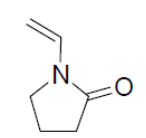N-Vinylpyrrolidone N-vinyl-2-pyrrolidone, Vinylpyrrolidone
- Applications
- Functions
Basic Information
| Chemical Structure |  |
|---|---|
| Chemical Formula | C6H9NO |
| Appearance and Main Properties | Appearance: Transparent liquid Molecular weight: 111.14 Purity: 99.5% min. Water content: 0.1 wt% max. 2-pyrrolidone: 1,000 ppm max. * The values listed in the table are not guaranteed values. |
| Chemical Substances Control Act (CSCA) No. | (Existing) 5-114 |
| EINECS | 201-800-4 |
| Fire Service Act | Hazardous materials, Category IV Class III Petroleums, Water-soluble liquids |
| Act on the Promotion of Chemical Substance Management | Act on the Promotion of Chemical Substance Management, Enforcement Ordinance, Appended Table 1 No. 339 |
| Hazardous Materials Database Registration | 4052-186631 |
| Stabilizer | BPA 10 ppm (N,N’-di-sec-butyl-p-phenylenediamine) |
Nippon Shokubai started the commercial production of N-vinylpyrrolidone in 2002, using our original gas phase dehydration method. Compared to the conventional Reppe process that uses acetylene as a raw material, this manufacturing method is a clean and safe process that has low risk of dangerous explosions.
Nippon Shokubai’s gas phase dehydration technology received the Kirkpatrick Chemical Engineering Achievement Award in 2003, given to the most noteworthy chemical-engineering technology commercialized anywhere in the world, and the Chemical Society of Japan Award for Technical Development in 2007.
Features and Properties
N-vinylpyrrolidone is a nonionic, hydrophilic monomer with the following features.
- N-vinylpyrrolidone can copolymerize with other monomers, and improve the adhesion, hydrophilicity, strength, and other properties of copolymers
- N-vinylpyrrolidone is soluble in water and most organic solvents, giving it a wide range of applications
- N-vinylpyrrolidone is used as reactive diluent (optical fibers, UV adhesives, UV ink, UV coatings) because of reactivity with UV irradiation.